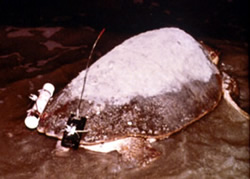Radio and Sonic Telemetry
 During
the 1977 - 1979 nesting season, sonic and radio transmitters were
placed on 37 adult female loggerheads by Wildlife Diversity biologists.
This study was the first successful attempt to acquire at-sea information
on
activity patterns, movements, and habitat utilization. The adult
female loggerheads remained in near-shore waters during the entire
nesting season. Internesting movements tended to be parallel to the
coast and were primarily to the south of the nesting beach. Shoals
and areas of high relief were found to receive concentrated use by
the turtles during the internesting period, while the areas immediately
adjacent to the nesting beaches had high use only by turtles about
to nest or following a night when egg deposition was not accomplished.
Turtles were inactive at night, and daylight activity involved either
long, straight-line movements or unpatterned activities in core areas.
The high use of near-shore waters by adult female loggerheads throughout
the nesting season clearly demonstrates the potential for conflict
with commercial shrimping activities. This potential may be reduced
somewhat by the turtles utilizing areas around shoals where trawler
operation is not possible. Finally, concentration areas do occur
around obvious physical features that can be considered essential
internesting habitats.
During
the 1977 - 1979 nesting season, sonic and radio transmitters were
placed on 37 adult female loggerheads by Wildlife Diversity biologists.
This study was the first successful attempt to acquire at-sea information
on
activity patterns, movements, and habitat utilization. The adult
female loggerheads remained in near-shore waters during the entire
nesting season. Internesting movements tended to be parallel to the
coast and were primarily to the south of the nesting beach. Shoals
and areas of high relief were found to receive concentrated use by
the turtles during the internesting period, while the areas immediately
adjacent to the nesting beaches had high use only by turtles about
to nest or following a night when egg deposition was not accomplished.
Turtles were inactive at night, and daylight activity involved either
long, straight-line movements or unpatterned activities in core areas.
The high use of near-shore waters by adult female loggerheads throughout
the nesting season clearly demonstrates the potential for conflict
with commercial shrimping activities. This potential may be reduced
somewhat by the turtles utilizing areas around shoals where trawler
operation is not possible. Finally, concentration areas do occur
around obvious physical features that can be considered essential
internesting habitats.



